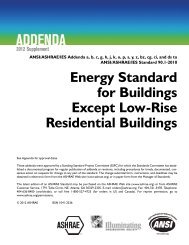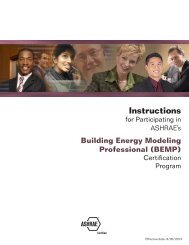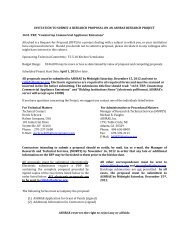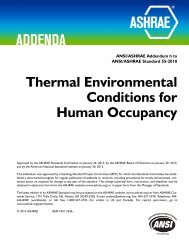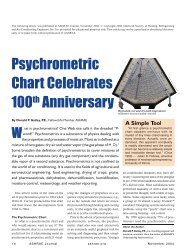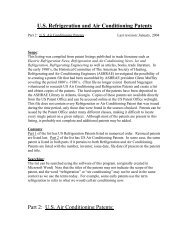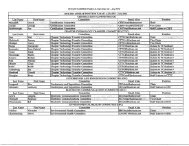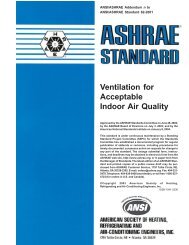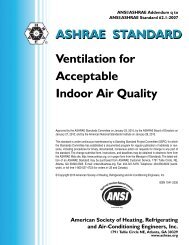ANSI/ASHRAE Standard 62.1-2007 ASHRAE STANDARD Ventilation
ANSI/ASHRAE Standard 62.1-2007 ASHRAE STANDARD Ventilation
ANSI/ASHRAE Standard 62.1-2007 ASHRAE STANDARD Ventilation
Create successful ePaper yourself
Turn your PDF publications into a flip-book with our unique Google optimized e-Paper software.
Equation A-2 shall be used for systems that provide all or<br />
part of their ventilation by recirculating air from other zones<br />
without directly mixing it with outdoor air, e.g., dual-fan dualduct,<br />
fan-powered mixing box, and transfer fans for conference<br />
rooms.<br />
A.1.2.2 Secondary Recirculation Systems. For “secondary-recirculation”<br />
systems wherein all or part of the supply<br />
air to each ventilation zone is recirculated air (which has<br />
not been directly mixed with outdoor air) from other zones,<br />
zone ventilation efficiency (E vz ) shall be determined in accordance<br />
with Equation A-3. Examples of secondary-recirculation<br />
systems include dual-fan dual-duct and fan-powered<br />
mixing-box systems, and systems that include transfer fans<br />
for conference rooms.<br />
E vz = (F a + X s · F b – Z pz · E p · F c)/F a<br />
(A-3)<br />
Where system air fractions F a , F b , and F c are determined in<br />
accordance with Equation A-4, A-5 and A-6, respectively.<br />
F a = E p + (1 – E p )· E r<br />
F b = E p<br />
(A-4)<br />
(A-5)<br />
F c = 1 – (1 – E z )·(1 – E r )·(1 – E p ) (A-6)<br />
Where the zone primary air fraction (E p) is determined in<br />
accordance with Equation A-7; zone secondary recirculation<br />
fraction (E r) is determined by the designer based on system<br />
configuration; and zone air distribution effectiveness (E z) is<br />
determined in accordance with Section 6.2.2.2.<br />
Note: For plenum return systems with secondary recirculation<br />
(e.g. fan-powered VAV with plenum return) E r is usually<br />
less than 1.0, although values may range from 0.1 to 1.2<br />
depending upon the location of the ventilation zone relative to<br />
other zones and the air handler. For ducted return systems with<br />
secondary recirculation (e.g., fan-powered VAV with ducted<br />
return), E r is typically 0.0, while for those with system-level<br />
recirculation (e.g, dual-fan dual-duct systems with ducted<br />
return) E r is typically 1.0. For other system types, E r is typically<br />
0.75.<br />
E p = V pz/V dz<br />
Where V dz is zone discharge airflow<br />
(A-7)<br />
Note: For single-zone and single-supply systems, E p is 1.0.<br />
A.1.3 System <strong>Ventilation</strong> Efficiency. The system ventilation<br />
efficiency shall be calculated using equal the lowest zone<br />
ventilation efficiency among all ventilation zones served by<br />
the air handler, in accordance with Equation A-38.<br />
E v = minimum (E vz ) (A-38)<br />
A.2 Alternative Calculations. The above equations may<br />
be rearranged to calculate other design parameters of interest<br />
based on known parameters. This includes, but is not limited<br />
to, calculating minimum zone discharge (supply) airflow<br />
(V dz) when the outdoor air intake flow V ot is known.<br />
Other mMass or flow balance equations for multiple-zone<br />
systems may also be used to determine system ventilation efficiency<br />
and other design parameters, provided that they result<br />
in outdoor air intake airflow (V ot ) that is within 5% of the<br />
airflow value obtained using the system ventilation efficiency<br />
(E v) calculated using Equation A-38 or they more accurately<br />
represent a particular system configuration.<br />
A.3 Design Process. The system ventilation efficiency and<br />
therefore the outdoor air intake flow for the system (V ot ) are<br />
determined as part of the design process are based on the<br />
design and minimum expected supply air flows to individual<br />
ventilation zones as well as the design outdoor air requirements<br />
to the zones. In this process, the designer shall assume<br />
that the critical zone is at its minimum supply or discharge airflow<br />
in VAV systems. For VAV system design purposes, zone<br />
ventilation efficiency (E vz ) for each ventilation zone shall be<br />
found using the minimum expected zone primary airflow<br />
(V pz ), and using the highest expected system primary airflow<br />
(V ps ) at the design condition analyzed.<br />
Note: The designer may increase Increasing the zone<br />
supply air flows values during the design process, particularly<br />
to the critical zones requiring the highest fraction of outdoor<br />
air, and thereby reduces the system outdoor air intake flow<br />
requirement determined in the calculation, sometimes dramatically.<br />
A.3.1 Selecting Zones for Calculation. Zone ventilation<br />
efficiency (E vz ) shall be calculated for all ventilation zones.<br />
Exception: Since system ventilation efficiency (E v) is<br />
determined by the minimum value of the zone ventilation efficiency<br />
(E vz), in accordance with Equation A-38, calculation of<br />
E vz is required only for the zone with the minimum value of<br />
Evz at ventilation design conditions. It is not required for any<br />
ventilation zone thatwhich clearly has an E vz value that is equal<br />
to or larger than that of the ventilation zone for which a calculation<br />
has been done.<br />
Note: The value of E vz for a ventilation zone will have a<br />
larger (or equal) value be equal to or larger than that for<br />
another ventilation zone if all of the following are true relative<br />
to the other ventilation zone with minimum E vz:<br />
1. Floor area per occupant (A z/P z) is no lower<br />
2. Minimum zone discharge airflow rate per unit area (V dz /A z )<br />
is no lower<br />
3. Primary air fraction E p is no lower<br />
4. Zone air distribution effectiveness (E z ) is no lower<br />
5. Area outdoor air rate R a is no higher<br />
6. People outdoor air rate R p is no higher<br />
If all of the above six parameters are the same for different<br />
spaces or areas, then those spaces or areas may be treated as<br />
a single zone for calculation of Evz.<br />
Example: In office buildings it is generally only necessary<br />
to calculate E vz for one typical interior ventilation zone, since<br />
the parameters listed above are generally equal for all interior<br />
spaces. If overhead supply air is used to heat the perimeter, it is<br />
generally also necessary to calculate E vz for the perimeter zone<br />
<strong>ANSI</strong>/<strong>ASHRAE</strong> Addenda g, r, and t to <strong>ANSI</strong>/<strong>ASHRAE</strong> <strong>Standard</strong> <strong>62.1</strong>-<strong>2007</strong> 7



